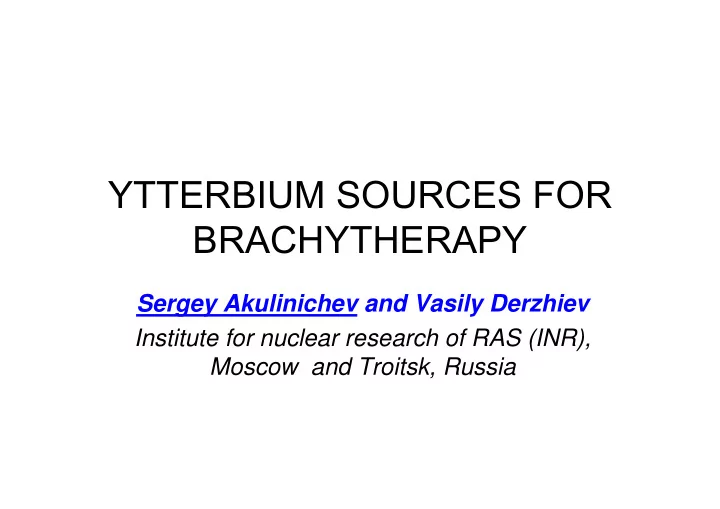

YTTERBIUM SOURCES FOR BRACHYTHERAPY Sergey Akulinichev and Vasily Derzhiev Institute for nuclear research of RAS (INR), Moscow and Troitsk, Russia
Preliminary schedule of the talk: 1. Medical applications of ytterbium sources 2. Source production using laser technology 3. Conclusions
Medical applications of ytterbium sources • In HDR Brachytherapy only 1 source of 6-20 Ci is short- time inserted via several (or one) catheters . • Usual isotopes: Co-60, Ir-192 or Yb-169. • Main localizations: prostate, breast, lung (possibly- vascular system).
Why ytterbium ? • Soft spectrum compared to Co-60 and Ir-192 ( ~ 92 KeV ), • Reduced dose to normal tissue and easier shielding, • High radioactivity - up to 6 Ci / mg for pure Yb-169 (only 0.6 Ci/ mg for Ir-192), • Half-life 32 days. easy shielding:
2. Source production using laser technology 3 steps: 1) Enrichment of initial isotope Yb-168 (AVLIS : Atomic Vapor Laser Isotope Separation), 2) Production of inner and outer capsules, 3) Activation by thermal neutrons Yb-168 → Yb-169,
AVLIS production of initial isotope Yb-168 ais Design of AVLIS facility: λ = 582.79 nm | 3> = 4f 13 ( 2 F 7/2 )6s 2 6p(7/2,3/2) 2 copper vapor lasers 120W λ = 581.067 nm 3 Dye laser |2> = 4f 13 6s6p 3 P 1 system ms λ = 555.648 nm Vacuum Chamber Control |1> = 4f 13 6s 2 1 S 0 With system extractor cooling system 3-step cascade of photo-ionization of Yb-168 (ais-auto ionization state)
The vacuum chamber with evaporator and extractor (the unique and most complicated part of the facility) Symmetry axis x collector Zone of selective ionization gap a Vapor source diaphragm y
Some methods of isotope enrichment laser photo-ionization AVLIS (the present technology) centrifuges I A VI I I B 1 2 H He I I A I I I A I V A V A VI A VI I A 3 4 5 6 7 8 9 10 Li Be B C N O F Ne 11 12 13 14 15 16 17 18 Mg Na Al Si P S Cl Ar I I I B I V B V B VI B VI I B VI I I I B I I B 19 20 21 22 23 24 25 26 27 28 29 30 31 32 33 34 35 36 K Ca Sc Ti V Cr Mn Fe Co Ni Cu Zn Ga Ge As Se Br Kr 37 38 39 40 41 42 43 44 45 46 47 48 49 50 51 52 53 54 Ag Rb Sr Y Zr Nb Mo Tc Ru Rh Pd Cd I n Sn Sb Te I Xe 55 56 57 72 73 74 75 76 77 78 79 80 81 82 83 84 85 86 Hg Cs Ba La Hf Ta W Re Os I r Pt Au Tl Pb Bi Po At Rn 87 88 89 104 105 106 107 108 109 Fr Ra Ac Rf 58 59 60 61 62 63 64 65 66 67 68 69 70 71 Lanthanide Dy Ce Pr Nd Pm Sm Eu Gd Tb Ho Er Tm Yb Lu series 90 91 92 93 94 95 96 97 98 99 100 101 102 103 Np Actinide series Th Pa U Pu Am Cm Bk Cf Es Fm Md No Lr
Parameters of 3- - Channel Dye Channel Dye - - Laser System Laser System for AVLIS of Ytterbium for AVLIS of Ytterbium Parameters of 3 Channel Wavelength, nm Dye Power, W Spectr.band, Pulse width, MHz ns 1 555 R110 5 500 15 2 581 R6G 5 500 15 3 582 R6G 20 3 · 10 4 20 Pumping: power 120 – 130W, λ = 510nm, f = 10kHz, τ = 20ns. Output of the system: 3 g/ year Final isotope content: • Yb – 168 – 20.21% (only 0.14 % in natural Yb) • Yb – 170 – 2.36% • Yb – 171 – 18.38% • Yb – 172 – 15.45% • Yb – 173 – 12.1% • Yb – 175 – 22.38% • Yb – 176 – 9.12%
Experimental source of Yb-169 produced on our facility, the measured activity 7 Ci (designed by Implant Sciences, USA) Nano-granules of ytterbium inner capsule
The inner capsule irradiation by secondary neutrons on INR proton linac Measured Ytterbium Spectrum 450000 400000 350000 s n 300000 to o h 250000 f P r o 200000 e b m 150000 u N 100000 50000 0 10 47 85 122 160 197 234 272 309 347 384 Energy, keV Spectrum of inner capsule (our result) Neutron irradiation facility RADEX 1- protons; 2 – vacuum channel 3 – tungsten target; 4 - moderator; 5 – irradiation channel; Standard spectrum of Yb-169 6- loading channel; 7 – iron shielding.
3. Conclusions • Titanium inner shell is unimportant for the source spectrum. • Our laser technology can provide for HDRB low cost ytterbium sources (electricity consumption is 8 times less compared to standard EM technology of Yb-168 extraction). • The sources with Yb-169 are less expensive than sources with Ir-192 and do not require a heavy shielding. • The HDRB with ytterbium can be carried out in any hospital. • The sources with ytterbium have additional clinical benefits (reduced dose to neighbor organs and normal tissue ). • Light mobile afterloaders designed for ytterbium sources are going to appear. • 2-3 facilities (as the one described above) can cover the needs of HDR brachytherapy in whole Russia.
Recommend
More recommend